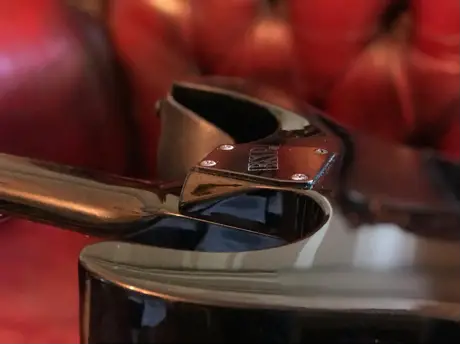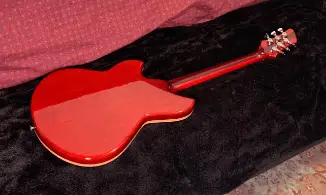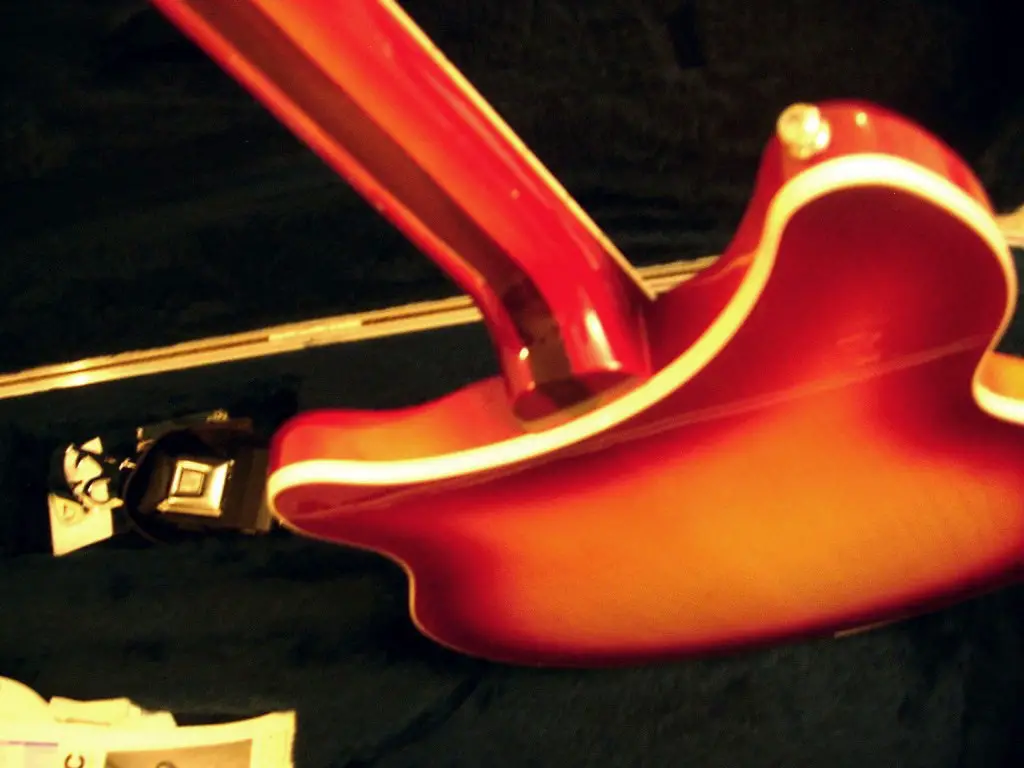Did you know that there are THREE ways guitars are manufactured? More specifically, there are 3 ways that the neck of the guitar, and the body of the guitar built-in production!
Guitar Neck Joint Types? There are THREE neck joint types which include bolt-on-neck, set-neck, and neck-through. The difference between bolt-on necks is that the neck and body is attached with a metal plate and screws. Whilst the set-neck is glued to the body, and the set-through neck and the body of the guitar is one whole piece.
In this article we will go over these in more detail…
1. Bolt-On Neck Type
The Bolt-on guitar neck construction consists of the guitar neck and guitar body to be manufactured separately and then attached together with a metal plate and screws. The bolt-on neck type is the easiest way to manufacture for mass production as the two parts (neck and body) can be produced separately and then attached later down the product line.

Generally, cheaper models use this neck fixture as is it the fastest and cheapest way of assembling the guitar. However, there are premium brands such as Fender that use this method of assembling guitars. Fender builds most of its electric instruments this way including the Fender Strat and Telecaster. However, they have a tightly fitted mortise-and-tenon in conjunction with the bolt-on to maintain a quality sound resonance. So these types of guitar still provide a really rich tone.
How is the Neck & Body Fixed With Bolt-On Neck?
Bolt-on-neck guitars are designed with a heel. This is the part of the guitar where the neck and the body meet. A heel is rectangular in shape which fits into the neck pocket of the body.
This is where the two pieces are fixed together by four screws and a metal neck plate. A good, tight-fitting neck pocket is essential to getting the best tone possible. Also, by over tightening the neck screws will not increase sustain and can actually produce cracks around the neck pocket. These cracks are somewhat common and do not affect the tone or stability of your guitar.
Advantages of Having Bolt-On Necks
Fender introduced the first widely available electric solid body guitar with a bolt on neck in 1950. The Telecaster had the advantages of being able to swap out necks or readily replace a broken one. In addition, these could be mass produced at a lower cost making them cheaper for the consumer.
Disadvantages of Having Bolt-On Necks
A common disadvantage is that sometimes you can have a mismatch between body and neck. For example, I own a Vintage Les Paul neck with an Epiphone Les Paul body, which was a standard issue. In addition, the most important disadvantage is the resonance.
Having a neck connected by a metal plate and screws does slightly affect the resonance of the sound the guitar outputs. Tone quality can be lost, making the sound output appear thinner. I would say from experience that this is the least rich sound of all the guitar neck joints.
The Type of Tone the Bolt-On Necks Produce
Bolt-on neck has a slower transference of acoustic energy because of the non-glued neck. Because of this, the output is a little more pop and attack from the strings producing a very bright sound. In combination with the type of wood can also effect the sound. Most bolt-on necks are made from maple wood and produce a brighter sound with more attack than a set neck.
the snap and pop of the bolt-on guitar emphasizes note definition, and a sharpness and firmness that contribute to a cutting tone. It’s what we often call “twang.”
The Strat’s ash or alder body, maple neck, string-through bridge block and floating vibrato tailpiece (or a semi-floating, steel Tele bridge plate with through-body stringing), 252″ scale length, and single-coil pickups collaborate to produce a bright, cutting sound. It makes sense that this neck joint would pair nicely with the single-coil pickups used on Stratocasters and Telecasters, given their inherently bright sound.
What Styles Work Best With Bolt-On Neck?
Generally, you can use bolt-on necks for any style and there is no limit. Musicians mostly use the Bolt-on Fender Stratocasters when playing blues and Rock and Roll because of the bright attack output. Which also includes why fenders are normally your first guitar, as blues is an awesome style to learn from. These are used from artists like Status Quo, Eric Clapton, Eric Johnson, Jeff Beck and Jimmy Hendrix.
However, like I said previously there is really no limit, as even power metal neo classical type’s artists such as Yngwie Malsteen, one of the most notorious artists in the world use a Fender Stratocaster with Bolt-on neck.
2. Set-Neck
The set-neck construction consists of the guitar neck and guitar body to be manufactured separately and then attached together with glue. The set-neck is the second easiest way to manufacture guitars as they require advanced craftsmanship for the attachment but not as complex as the through-neck (discussed below).

Set-necks are the most popular on acoustic guitars. Almost all major acoustic guitar manufacturers use set-in necks, with notable exceptions being Taylor Guitars, Godin Guitars, and Collings Guitars. In the electric guitar market, Gibson produces all of its high-end electric offerings as set-neck models.
How is the Neck and Body Fixed With Set-Necks?
Set-neck is a method of guitar construction that involves joining neck and body with a tightly fitted mortise-and-tenon or dovetail joint, secured with some sort of super strong glue.
The set-neck are easy to manufacture for mass production as the two parts (neck and body) can be produced separately. However, they are slightly difficult to fix together because they require mortise-and-tenon or dove tail joint. Which is the advanced craftsmanship spoken about above. They can then later attached down the product line.
Advantages of Having a Set-Neck
It is a common belief that the set-neck produces a stronger body-to-neck connection than a bolt-on neck. But, overall combined with the glue and advanced craftsmanship improves the resonance.
This is how the sound travels through the fret board and resonates out of the body of the guitar. Unlike bolt-on necks the tone travels from the neck to the body and is not lost because of the glue. Meaning, there is always precious contact between the body and the neck, which produces a fuller sound (even with the cheaper models).
However, a well-executed bolt-on neck joint is equally strong and provides similar neck-to-body contact, especially with the high-end Fender models. Moreover, you can’t really a low end set-neck electric guitar.
Disadvantages of Having a Set-neck
The set-neck are much harder to produce because require more materials and craftsmanship for production.
Overall, this increase of cost is pushed onto the consumer. With my set-neck guitars, I often have trouble with them able to hold the tuning as well. From my experience, tuning can commonly slip in practice and especially if playing live (especially with the lower end set-neck models).
But, I have never played live with a Gibson Les Paul to test out the really expensive models. If you have then share you experience in the comments section below.
The Type of Tone the Set-Neck Produce
Set-necks have more thorough transference of energy through the fretboard to the body of the guitar. This means the vibrations can travel more freely producing a thicker, juicier sound.
The set neck’s tight coupling facilitates ripples of vibrational energy that round out, thicken, and slightly fuzz up the note, blurring it in a way that fattens the body of the note.
Although, there are many other constructional aspects besides neck design serve to emphasize the fat/warm, bright/snappy dichotomy many guitarists prefer.
What Styles Work Best With Set-Neck?
Les Paul being a common example of a set-neck can be used for anything from rock to metal because of the thicker, smoother sound it provides.
3. Set-Through Neck
A set-through guitar neck is the name given to the type of manufacturing that produces the guitar neck and body together in one piece.
Set-through necks are relatively uncommon, only a handful of manufacturers produce such neck joints. Sometimes, especially if neck extension inside a body does not fill full scale length, such neck joint is marketed as an extended pocket set-in neck or deep-set neck.
How Are Set-Through Guitars Manufactured?
On the set-through guitars, the neck continues all the way through the body as a single piece of wood.
Later, two pieces of wood are attached with glue that forms the wings of the guitar (top and bottom of the body).
The pickups are then mounted on the single piece of wood that runs through the body.
Advantages of Set-Through Guitar Necks
Neck-through guitars have many benefits. The first, is that because the neck and the body are one pierce they’re stronger and stay in tune much better.
- Long neck plank
- Glueing (setting) the long neck inside the deep pocket, or attached wings compared to the set-neck
- improved tone and sustain (, not laminated as in neck-through)
- brighter tone (due to set joint)
- comfortable access to top frets (due to lack of hard heel and bolt plate)
- better to hold tuning because of wood stability
Overall, the guitar will sustain for longer due to deep insertion and body made of single piece of wood. This means adding effects pedals like distortion, phaser, and even delay will produce a greater sound.
Disadvantages of Set-Through Guitar Neck
The set-through guitar comes with some disadvantages due to the complexity of manufacturing. This result is skilled labour, which increases manufacturing costs. Another disadvantage is maintenance costs, time of producing.
What is the Difference in Sound Quality Between Glue or Bolted Attached Neck?
A glued neck transfers the resonance between neck and body more freely and immediately than using bolted attachments. This means we hear the glued neck with a little more warmth and fullness. By having, a less free flowing vibration can be heard as a more snap and twang in the bolt-on guitar.
The main reasons for these basic tonal differences are that the lesser, slower transference of acoustic energy from the non-glued neck. But, On the other hand, the snap and pop of the bolt-on guitar emphasizes note definition, and a sharpness and firmness that contribute to a cutting tone.
Glued VS Blot-In For Live Gigs?
Should I invest in a fixed neck guitar for playing live? Bluntly speaking, a bolt neck guitar investment should be taken into consideration for the reason that my tuning slips if I bang it (for my set-neck ibanez).
You definitely cannot stand the nuisance of being out of tune when you have to hit your instrument a lot on stage in your lifetime performance. In short, if you would like to minimize the chance of underperformance so a bolt neck would be a better option.
I would not use a neck-through either. Because it is a gem and will probably get damaged.
Should I invest in a fixed neck guitar for recording in a professional studio?
There will be no specific answer for this question. It depends on the situation. Technically a set neck or neck-through will deliver a better sound quality without any unwanted sounds such as twang, therefore theoretically it will be prioritized when it comes to standards.
However, if you are immersed in reputable brands such as Fender, even God cannot prevent you from buying a real McCoy of bolt neck guitar. Once again, it is up to you, so just follow your heart (and your money as well).
The only other option is try both and layer guitars, experiment and see what you can get by merging tonal differences.
Conclusion
If you are seeking for a new guitar, you still need to try as many instruments of all types in your desired price range as you can get your hands on. Let your fingers and ears make the final decision.
Different neck joints definitely contribute to different-sounding guitars, but the neck design you choose should depend entirely upon what is right for you and your music.

